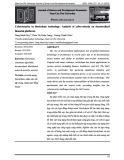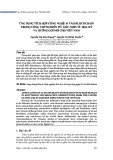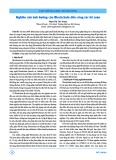106
JOURNAL OF SCIENCE AND TECHNOLOGY DONG NAI TECHNOLOGY UNIVERSITY
Special Issue
FORENSIC ANALYSIS OF CRYPTOCURRENCY TRANSACTIONS: INSIGHTS FROM ANDROID DEVICES CONNECTED TO HARDWARE WALLETS
Van Ba Tai1, Chen Min Huang2
1Faculty of Engineering, Dong Nai Technology University, Bien Hoa City, Vietnam 2College of Intelligent Science & Technology, I-Shou University, Kaohsiung City, Taiwan *Corresponding author: Van Ba Tai, vanbatai@dntu.edu.vn
GENERAL INFORMATION
Received date: 26/03/2024 the anonymity of Revised date: 03/05/2024
on android analyzing Accepted date: 11/07/2024
KEYWORD
Cryptocurrency forensics;
Android devices;
Hardware wallets;
Artifact analysis;
Blockchain transactions.
investigative
ABSTRACT While blockchain ledgers publicly record cryptocurrency transaction participants transactions, presents challenges for forensic investigation. This study concentrates device-based cryptocurrency transactions tethered to hardware wallets: D'cent Biometric Wallet and Ledger Nano S. Through meticulous scrutiny of artifacts produced by these tools – we engineered CryptoInfoGetter; an application designed to extract data related to cryptocurrencies. We developed the tool 'CryptoInfoGetter' for extracting cryptocurrency-related data from artifacts generated by two specific hardware wallets--the D'cent Biometric Wallet and Ledger Nano S; this development was a result of our analysis into forensic aspects of Android device-connected crypto transactions. Our analysis unveils valuable insights: wallet details; transaction histories and hardware wallet configurations—these provide pivotal evidence for forensic investigations. We also confront challenges--the dynamic nature of transactions, anonymity features in particular—and deliberate over opportunities to bolster techniques. The advancement of cryptocurrency forensic analysis necessitates indispensable collaboration among researchers, law enforcement personnel, as well as industry stakeholders.
1. INTRODUCTION forensic
promising decentralized
distributed ledger, it also presents challenges in the investigation, particularly realm of regarding the anonymity of transaction participants. This anonymity feature has unfortunately been exploited by nefarious actors for illicit activities, ranging from money laundering to the facilitation of illegal transactions (Qi et al., 2022; Saeed Rasheed et al., 2023; Uddin et al., 2021). Cryptocurrencies, epitomized by Bitcoin, have emerged as a disruptive force in the realm of finance, and pseudonymous transactions through the innovative use of blockchain technology (Suratkar et al., 2020). technology offers unparalleled While this transactions on a in transparency recording
107
JOURNAL OF SCIENCE AND TECHNOLOGY DONG NAI TECHNOLOGY UNIVERSITY
Special Issue
In
tracing cryptocurrency
in lies tracing investigators
transactions
highlights the
require findings underscore
illicit the context of combating such activities, forensic analysis plays a pivotal role in unraveling the complexities of cryptocurrency transactions. One of the critical challenges faced by forensic these transactions back to their originators, a task made increasingly difficult when utilizing hardware wallets – secure devices designed to store cryptocurrency keys offline (Aiolli et al., 2019; Thomas et al., 2020). Unlike traditional centralized exchanges, which personal often verification, hardware wallets offer users a level of anonymity that complicates the process of tracking and attributing transactions (Dmitrienko et al., 2017; M. M. Mirza et al., 2022). default.realm file of the D'cent Wallet and the AsyncStorage file of Ledger Live, which are crucial transactions and for identifying hardware wallet configurations. Our study demonstrated that the artifacts from these applications can provide valuable evidence for and constructing timelines of the understanding wallet usage. Additionally, research of effectiveness CryptoInfoGetter in simplifying the extraction process, offering a practical solution for forensic investigators. These the potential of artifact analysis in enhancing the forensics and capabilities of cryptocurrency addressing associated with challenges the anonymous digital transactions.
forensic
in criminal
Our research tackles this challenge: we conduct forensic analysis on artifacts that Android devices connected to hardware wallets generate. We specifically delve into examining the database files produced by two leading hardware wallets - D’cent Biometric Wallet and Ledger Nano S- when operated with Android devices; this investigation aims to address a crucial issue—extracting valuable cryptocurrency-related information—with potential application investigations where misuses of cryptocurrencies are involved (He et al., 2020; Khan et al., 2019; D. Mirza & Rahulamathavan, 2023). In this paper, we present the findings of our analysis, detailing the methodologies employed, the types of information obtained, and the implications for investigations. Additionally, we introduce CryptoInfoGetter, a tool developed based on our research findings, which facilitates the extraction and analysis of cryptocurrency-related data from Android devices. Through this research, we seek to contribute to the advancement of forensic techniques in combating cryptocurrency-related crimes and to stimulate further inquiry into this burgeoning field.
2. RELATED WORKS
The
facilitate To address these challenges, our study focuses on analyzing artifacts generated by hardware wallet applications used on Android devices. We investigated two specific hardware wallets: the D'cent Biometric Wallet and the Ledger Nano S. Our analysis involved examining the database files created by these applications to uncover critical information such as wallet details, transaction histories, and hardware wallet configurations. We developed a forensic tool named CryptoInfoGetter the extraction and analysis of to cryptocurrency-related data from these artifacts.
store keys Key findings from our research include the the identification of significant data within forensic analysis of cryptocurrency transactions has been a subject of considerable research interest, driven by the widespread adoption of cryptocurrencies and the challenges posed by their pseudonymous nature. Scholars have explored various methodologies for analyzing blockchain transactions to trace the flow of cryptocurrencies and identify illicit activities, leveraging techniques such as blockchain analytics and graph-based analysis. Additionally, there has been a growing focus on the forensic analysis of hardware wallets, which offline, cryptocurrency necessitating the development of techniques for
108
JOURNAL OF SCIENCE AND TECHNOLOGY DONG NAI TECHNOLOGY UNIVERSITY
Special Issue
techniques forensic tools and to aid
extracting and analyzing data from these devices to uncover evidence of illicit transactions. Mobile devices, particularly Android smartphones, have also been the subject of forensic analysis, with researchers examining application data and system files to recover cryptocurrency-related artifacts such as wallet addresses and transaction histories. A techniques have been plethora of developed in cryptocurrency forensic including blockchain explorers, investigations, wallet analyzers, and specialized forensic software. considerations Moreover, ethical legal and surrounding cryptocurrency forensic analysis, such as user privacy and data protection, have also been explored to ensure compliance with relevant laws and regulations. By building upon and extending the findings of previous research in these areas, our study aims to contribute to the development of effective for combating cryptocurrency-related crimes and enhancing the security of blockchain ecosystems. The comparison of some current related works with their advantages and disadvantages in relation to the proposed tool, CryptoInfoGetter, shown in Table 1.
Table 1. Comparison of Cryptocurrency Forensic Tools: Advantages and Disadvantages Relative to CryptoInfoGetter
Related Work
CipherTrace
FTK Imager
X1 Social Discovery
EnCase Forensic
Chainalysis Reactor
for
digital
Advantages
for
in anti-
in
Reliable
forensics
tool.
- Capable
of creating forensic
images.
-
Broad support for
various
file
systems.
Comprehensive forensic tool for various digital investigations.< br>- Supports a wide range of file systems and devices.
Comprehensive
blockchain
analysis.
-
Provides
detailed
transaction
mapping.
-
Well-
established
the industry.
Effective
for
extracting data
from
social
media and web-
based
sources.
-
Useful
gathering
contextual
evidence.
Advanced
analytics
cryptocurrency
transactions.
- Integration with
various
blockchain
networks.
-
Strong
money
laundering.
Disadvantages
effective technical
Expensive.
-
Requires
subscription.- Limited to
on-chain
data
analysis.
High cost.
-
Primarily focused
on
on-chain
data.
-
Limited support
for offline wallet
data.
Not specifically
designed
for
cryptocurrency
analysis.
-
Less
for
wallet data.
Primarily used for
digital
general
forensics.
-
Limited
cryptocurrency-
specific
analysis.
-
Requires manual
analysis
of
extracted data.
Expensive.
General-
-
purpose
tool
with
limited
cryptocurrency-
specific
features.
-
Requires
extensive
training.
provides
Comparison to CryptoInfoGetter
and
the
CryptoInfoGetter
offers analysis of
wallet
offline
artifacts, which
CipherTrace does
cover.
-
not
More
cost-
for
effective
specific device-
based
investigations.
CryptoInfoGetter
is specialized for
cryptocurrency
wallet
artifacts.
-
Provides
automated
extraction
analysis,
streamlining
process.
CryptoInfoGett
er focuses on
data
technical
from
cryptocurrency
wallets.
-
More suited for
direct
cryptocurrency
forensic
investigations.
CryptoInfoGett
er focuses on
artifact analysis
from Android
devices.
-
Provides
detailed
information
from hardware
wallet
apps,
complementing
on-chain data.
CryptoInfoGett
er
targeted
analysis
for
cryptocurrency
wallets.
-
Simplifies and
on
focuses
data
relevant
extraction,
making it more
accessible
for
specialized
investigations.
109
JOURNAL OF SCIENCE AND TECHNOLOGY DONG NAI TECHNOLOGY UNIVERSITY
Special Issue
3. ARITIFACT ANALYSIS
and version details. The analysis was facilitated by the utilization of various tools and applications, as detailed in Table 3, which included D’cent Wallet, Ledger Live, and the Android Debug Bridge (ADB).
Table 2. Tools and Applications Used
Version Usage Software Name
5.24.1 identified D'cent Wallet Android Application for D'cent Hardware Wallet
3.20.1 Ledger Live Android Application for Ledger Hardware Wallet
33.0.3 Android File Acquisition Android Debug Bridge
In our analysis, we utilized a rooted Samsung
Galaxy S10 5G running Android 12, along with two
prominent hardware wallets: the D’cent Biometric
hardware wallet and the Ledger Nano S. To
interface with these hardware wallets, we employed
their
respective Android-specific applications,
D'cent Wallet for D'cent and Ledger Live for
Ledger. Our investigation primarily centered on
scrutinizing the database files generated within the
/data/data/
Table 1. Full Specifications of the devices used in the study
information, Version Device Type Device Name
Android 12 Android
D'cent Kernel Version
2.25.2.83c3
KSM
Version 1.0.0.1139 Galaxy
S10 5G
D'cent
Biometric
hardware
wallet
Ledger Ledger
Nano S MCU Version
2.1.0
SE Version
1.12
PC Windows 10 Pro Delving deeper into the examination of the D’cent Wallet, identified through the package name com.kr.iotrust.dcent.wallet, we found that it stores its data within the default.realm file, residing in the files folder. This file contained a wealth of cryptocurrency-related including wallet details, hardware wallet specifics, and pending transactions. Notably, wallet labels and addresses served as vital indicators of usage intent and transaction histories, while hardware wallet data aided in pinpointing cold wallets owned by users, crucial for investigative purposes. Moreover, pending transaction details, accessible solely from the Android device and mempool, provided concrete evidence of transactions originating from the specific Android device, facilitating the creation of a timeline for transaction events.
The detailed specifications of the devices used are outlined in Table 2, encapsulating the Android device, hardware wallets, and the operating system utilized. Notably, the Galaxy S10 5G ran on Android 12, while the D’cent Biometric hardware wallet and Ledger Nano S boasted specific kernel The Ledger Live application, identified through the package name com.ledger.live, stored its data within the AsyncStorage file situated in the databases folder. This Key-Value database file primarily housed details regarding cryptocurrency wallets, hardware wallets, transactions, pending
110
Special Issue
for
thereby ensuring
and
integrity. This serves as a cornerstone
streamlining file,
in
transactions, and the application's initial execution date. Wallet labels were instrumental in discerning the purpose of usage, while hardware wallet information aided in identifying cold wallets, offering valuable investigative insights endeavors. Unlike the D’cent Wallet, Ledger Live retained all transaction information within the database the process of constructing a timeline. Pending transaction details corroborated transactions originating from the furnishing precise specific Android device, transaction creation timeline construction.
timestamps for
4. IMPLEMENTATION AND UTILIZATION OF THE TOOL
In this section, we detail the implementation and utilization of CryptoInfoGetter, a tool developed based on the artifact analysis results presented in Section previous of this paper. CryptoInfoGetter serves as a specialized solution for acquiring essential cryptocurrency-related data from Android devices connected to hardware wallets. Leveraging the insights gleaned from our analysis, we crafted CryptoInfoGetter using C++ the Visual Studio 2019 environment, within ensuring compatibility with the Windows operating system. To access and parse the realm file containing D'cent's application data, we integrated the open-source Realm Core library into our tool. Similarly, for extracting information from the AsyncStorage file housing Ledger's application data, we harnessed the capabilities of the open- source SQLite3 library.
allowing interface,
insights
understanding
and
of
JOURNAL OF SCIENCE AND TECHNOLOGY DONG NAI TECHNOLOGY UNIVERSITY Once the extraction is complete, the acquired cryptocurrency data holds significant value for forensic investigations. Forensic analysts can cross-verify this data by querying the blockchain network for validity, its validated reliability information for constructing comprehensive crime timelines or serving as compelling evidence legal proceedings. Notably, CryptoInfoGetter enables analysts to uncover potential criminal intent by analyzing data not directly recorded on the blockchain network, including wallet labels, pending transactions, and hardware wallet specifics. Moreover, the tool provides insights into users' patterns of hardware wallet usage, including details on the types and quantities employed, thereby enriching investigative efforts. CryptoInfoGetter emerges as a powerful asset for forensic analysts, offering a robust means to gather, verify, and utilize cryptocurrency-related data within the context of criminal investigations. By streamlining the extraction process and providing valuable insights, CryptoInfoGetter stands at the forefront of cryptocurrency forensic analysis, empowering investigators to unravel complex digital transactions and combat cryptocurrency-related crimes effectively. The specific data retrieved from the D'cent wallet application, including detailed information on wallet addresses, transaction histories, and hardware wallet configurations. The improved background in the figure enhances visibility, allowing for a clearer interpretation of the extracted data, shown in Figure 1. The data extracted from the Ledger wallet application, the wallet details, providing into transactions, and pending transactions. The enhanced background of this figure ensures better the visualization information retrieved from the Ledger wallet, shown in Figure 2.
Upon execution, CryptoInfoGetter offers a forensic user-friendly investigators to specify their desired extraction option - either '-dcent' for D'cent information or '- ledger' for Ledger information - via the command prompt (cmd). Additionally, users must provide the path where the files from the Android device are stored to initiate the extraction process seamlessly.
111
JOURNAL OF SCIENCE AND TECHNOLOGY DONG NAI TECHNOLOGY UNIVERSITY
Special Issue
Figure 1. Illustrates the execution outcome of CryptoInfoGetter with the D'cent option.
Figure 2. Depicts the execution result of CryptoInfoGetter with the Ledger option.
5. DISCUSSION
the Our artifact analysis offers significant insights into the realm of cryptocurrency transactions conducted via Android devices connected to hardware wallets. By scrutinizing the data generated by the D'cent Biometric Wallet and Ledger Nano S, we've uncovered valuable information crucial for investigation of forensic analysis and findings cryptocurrency-related crimes. The underscore the forensic significance of artifact analysis, providing forensic analysts with a treasure trove of data including wallet details, transaction histories, and hardware wallet configurations, pivotal for tracing fund flows and identifying transaction participants. However, this analysis also illuminates challenges such as the dynamic nature of cryptocurrency transactions and the inherent anonymity features, which complicate accurate tracking and attribution. Despite these challenges,
112
JOURNAL OF SCIENCE AND TECHNOLOGY DONG NAI TECHNOLOGY UNIVERSITY
Special Issue
this interpreting to the tailored
significant another is
techniques to protect user data, creating barriers to accessing and information. Forensic analysts must develop and apply methods to effectively bypass or decrypt such data while maintaining its integrity, which requires advanced technical skills and tools. Volume and complexity of data challenge. Cryptocurrency transactions generate vast amounts of data, often involving multiple wallets and addresses. Analyzing this data to extract relevant information can be overwhelming and complex. Effective data management strategies and analytical techniques are essential to handle and sift through the large volumes of data efficiently.
instrumental
constantly adapt
our study highlights opportunities for enhancing investigative techniques and developing specialized forensic analysis of tools cryptocurrency transactions. Crucially, ensuring the validity and reliability of the obtained data remains paramount, necessitating cross-verification through blockchain network queries to corroborate extracted information. Ethical and legal considerations loom large, demanding adherence to ethical guidelines, data protection laws, and privacy concerns to safeguard the integrity and admissibility of forensic findings in legal proceedings. Looking ahead, future research should focus on addressing emerging challenges, advancing investigative methods, and exploring the impact of evolving technologies like decentralized finance (DeFi) and non-fungible tokens (NFTs) on forensic practice. Collaboration among researchers, law enforcement agencies, and in industry stakeholders will be advancing the field of cryptocurrency forensic analysis and countering evolving threats in the digital landscape.
Evolving technologies in the cryptocurrency introduce additional difficulties. The sector continuous development of new wallet types, blockchain protocols, and decentralized finance (DeFi) platforms means that forensic tools and methodologies must to accommodate novel data structures and transaction technological formats. Staying updated with advancements is critical for maintaining effective forensic practices.
these
Jurisdictional and legal issues present another layer of complexity. Cryptocurrency transactions frequently span international borders, leading to varied regulations across different jurisdictions. This variability can create legal challenges for forensic investigations, affecting the admissibility of findings legal in court. Navigating complexities requires careful consideration of international laws and regulations.
6. CONCLUSION
lead
Our artifact analysis offers significant insights into the forensic investigation of cryptocurrency transactions facilitated through Android devices connected to hardware wallets. Beyond the primary challenge of tracing transactions back to their originators, several other critical issues impact the effectiveness of cryptocurrency forensics. Data integrity and accuracy remains a fundamental concern. Ensuring that the data extracted from Android devices and hardware wallets is both accurate and unaltered is crucial for reliable forensic analysis. Artifacts can be prone to modification or corruption, which may to erroneous conclusions. To mitigate this, forensic tools must undergo rigorous validation processes to confirm their reliability and accuracy in data extraction.
Data encryption and obfuscation forensic
Our investigation into the forensic analysis of cryptocurrency transactions conducted via Android devices connected to hardware wallets has illuminated critical facets of this complex digital ecosystem. Through meticulous artifact analysis and the development of the CryptoInfoGetter tool, we have unveiled a wealth of data pertaining to complicate cryptocurrency wallet sophisticated encryption further investigations. Many employ obfuscation applications and
113
JOURNAL OF SCIENCE AND TECHNOLOGY DONG NAI TECHNOLOGY UNIVERSITY
Special Issue
REFERENCE
wallet details, transaction histories, and hardware wallet configurations. These insights serve as invaluable assets for forensic investigators, offering a pathway to trace fund flows, identify transaction participants, and ultimately unravel the intricate web of cryptocurrency-related crimes.
Aiolli, F., Conti, M., Gangwal, A., & Polato, M. (2019). Mind your wallet’s privacy: Identifying Bitcoin wallet apps and user’s actions through network traffic analysis. Proceedings of the 34th ACM/SIGAPP Symposium on Applied Computing, 1484–1491. https://doi.org/10.1145/3297280.329743 0
anonymity embedded
for
with
While our study has shed light on the forensic significance of artifact analysis, it has also underscored the multifaceted challenges inherent in investigating cryptocurrency transactions. The dynamic nature of these transactions, coupled with in features the cryptocurrencies, presents formidable hurdles for forensic analysts. However, we remain optimistic about innovation and the opportunities advancement in this field.
Dmitrienko, A., Noack, D., & Yung, M. (2017). Secure Wallet-Assisted Offline Bitcoin Double-Spender Payments Revocation. Proceedings of the 2017 ACM on Asia Conference on Computer and Communications Security, 520–531. https://doi.org/10.1145/3052973.305298 0
stakeholders. sharing Through expertise—we
into cryptocurrency
He, D., Li, S., Li, C., Zhu, S., Chan, S., Min, W., & Guizani, N. (2020). Security Analysis of Cryptocurrency Wallets in IEEE Android-Based Applications. Network, 114–119. 34(6), https://doi.org/10.1109/MNET.011.2000 025
Looking ahead: in navigating the evolving landscape of cryptocurrency forensic analysis, paramount importance will lie with collaboration among researchers; law enforcement agencies and fostering industry can partnerships--and address emerging challenges collectively, develop cutting-edge investigative techniques and bolster the efficacy of forensic tools. Our endeavors must always prioritize ethical and legal considerations. Delving deeper forensic analysis necessitates us to maintain stringent ethical guidelines, adhere to data protection laws, and respect individual privacy rights. We can ensure the integrity and admissibility of our forensic findings in legal proceedings by upholding impeccable standards of ethical conduct..
the
Khan, A. G., Zahid, A. H., Hussain, M., & Riaz, U. (2019). Security Of Cryptocurrency Using Hardware Wallet And QR Code. 2019 on International Conference Innovative Computing (ICIC), 1–10. https://doi.org/10.1109/ICIC48496.2019. 8966739
increasingly in an Our study represents a significant step forward in the field of cryptocurrency forensic analysis. By leveraging insights gleaned from artifact analysis and embracing a collaborative approach, we can fortify our efforts to combat cryptocurrency- related crimes and uphold the integrity of digital transactions interconnected world.
Mirza, D., & Rahulamathavan, Y. (2023). Security Analysis of Android Hot Cryptocurrency Wallet Applications. In C. Hewage, Y. Rahulamathavan, & D.
114
JOURNAL OF SCIENCE AND TECHNOLOGY DONG NAI TECHNOLOGY UNIVERSITY
Special Issue
International
Ratnayake (Eds.), Data Protection in a Post-Pandemic Society (pp. 79–111). Springer Publishing. https://doi.org/10.1007/978-3-031- 34006-2_3


























